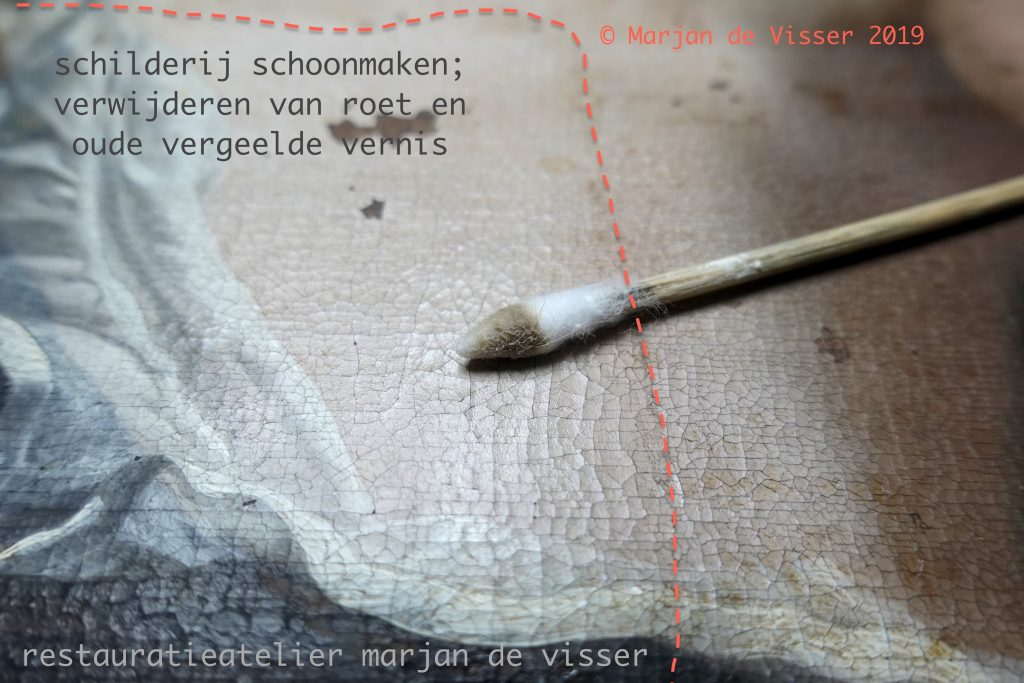Cleaning and cleaning paintings
Cleaning paintings is an important treatment in painting restoration. A dirty painting is not attractive, and a dirty painting will age faster than a clean painting. In painting restoration, cleaning paintings is the biggest challenge. Cleaning paint layers, cleaning varnishes, but also cleaning the back side of a painting. Removing varnish is also part of cleaning during the restoration of paintings.
Cleaning a modern painting is a real challenge
Restoring and cleaning unvarnished paintings is, therefore, a specialty in the Marjan de Visser restoration studio. Testing and applying cleaning techniques requires insight into the materials used, and therefore knowledge of chemistry is necessary.
★Contact us★
Cleaning paintings is important because the painting is often more beautiful afterwards
A clean painting also lasts longer. Cleaning a painting seems easy, but if the wrong means are used, the paint or varnish can also be damaged. An oil painting therefore requires a completely different approach than an acrylic painting or a tempera painting. Research into the composition of the materials used prior to testing and cleaning is important during painting restoration.
The composition of the dirt is an important factor in cleaning paintings
After all, the type of dirt determines the choice of cleaning agents. The challenge in restoration is therefore also mixing the right cleaning agent. In the Marjan de Visser restoration studio, the restorers use The Modular Cleaning Program (the MCP). This is a method in which the dirty surface is measured for acidity (pH) and conductivity (mS). Tests can be carried out quickly and easily with buffers, metal binders (chelators) and soaps (surfactant).
Cleaning techniques and materials for painting

The conservator can make the right mixture for every painting, varnished or unvarnished paint layers. Sometimes conservators in the studio choose to clean with a cotton swab and / or brushes. The use of equipment that extracts the dissolved dirt: the aspirator is one of our options. Another time, the water mixture is bound in a gel or emulsion. The photo with this text shows the cleaning of an oil painting with a layer of yellow nicotine. The nicotine was removed with a white brush and Pemulen TR2 gel.
Cleaning a painting; remove soot from the cracks in the paint layer
Here is a wonderful example of removing dirty layers of soot from a varnished painting. It is a mantelpiece by Wassenberg that was in the studio for restoration in 2019. We could see from paint cross-sections that the painting had been varnished several times in the past. The last time was in 1953. At least the newspaper on the back has a date from March 1953 and pictures of the flood disaster. And there are also all kinds of exciting and special discoveries. Just look at these pictures. These are the first tests of dirt cleaning and varnish removal. That’s cleaning a painting !! Later in the cleaning process of the chimney by Wassenberghit turned out that cracks in the paint layer also contain soot. As a result, the painting still looks gray. These last layers of dirt were removed with a Pemulen TR2 emulsion.
Cleaning painting; an example of cleaning with Pemulen ® gel

Another example where a very dirty paint surface could be cleaned using Pemulen gel. In contrast to the Pemulen emulsion, no solvents have been added to this agent. Here too we see a beautiful and safe result of cleaning a painting.
Schilderij schoonmaken; reiniging van de achterzijde van het linnen
extracting dust from the back of the linen Not all cleanings are immediately visible. You will not see this when dirt and dust have been removed at the rear with a vacuum cleaner and brush. Nevertheless, this is an important treatment for painting cleaning because it prevents the damage of fungi and insects!










